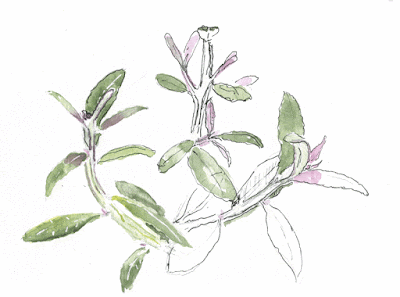It's a perennial, and it does have a big black root. Its main charm is its foliage, not its flowers. "Not showy" is sort of an understatement, though the bloom spikes themselves are quite interesting. It is a member of the Aster family. Flower heads grow in a spiral around a long, rather spongy and felty stalk at the ends of branches. There are only disc florets, not petal-like ray flowers. The flowers themselves are pale white turning brown with age. Aster flowers don't have a traditional green calyx. Instead, they have a ring of persistent chaff-like hairs (pappus) at the bottom. The pappus often aids in seed dispersal. Milkweed seeds are attached to a similar structure, though it is not related to the calyx. As the achenes (dry fruit consisting of a hard outer coating surrounding a single seed) mature, the pappi can become very noticeable. Blackroot's interesting texture and form, beautiful leaves and strange stems more than compensate for the bland flowers.
 |
Numerous disc florets and pappi |
One of the most interesting thing about the plant is its decurrent leaf bases. The leaves are not stalked, but attached directly to the stem, and the base of each leaf extends like a wing down the stem until it is interrupted by a different leaf, which starts the process anew. This gives the plant an even more 3-dimensional look, and certainly adds interest. The stems are soft and pithy, turning more woody with age. Pruning old, dry stems keeps the plants looking their best.
 |
| StemStudies |
 |
Detail of Veins, Pressed Leaf, Leaf Rubbing, Color Trials |
Beautiful rose-pink new growth is also one of the plant's charms. The coloration appears on new leaves, flower spikes, and even stems.
Pterocaulon pyncnostachium is very tough, and can grow in extreme drought and sun, or in more moist and shady conditions. It also can be grown in a pot. In my yard it goes dormant or semi-dormant in winter, probably due more to lack of water than cold temperatures. It is not troubled by insects or diseases. Its stems grow both upright and in gentle arcs. It really is a very desirable plant for a naturalistic garden, but does not seem to be readily available. I got my plant from a friend, sadly no longer living, who had a small native plant nursery.
 |
| Pterocaulon pyncnostachium - "Blackroot" |
An herbal concoction called "Blackroot" is available commercially . This is not made from the same plant, but instead, is a preparation of Veronicastrum virginicum, also called "Culver's Root." Just one more example of why scientific names are a good idea.
Text, illustrations, photos by Jeanette Lee Atkinson

No comments:
Post a Comment